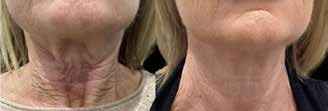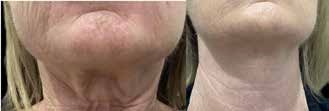TREATING THE NECK WITH POLYNUCLEOTIDES
Nurse prescriber Amy Lamb shares a case study whereby neck sagging and significant wrinkling were improved using this biostimulation procedure
AMY LAMB
Amy Lamb is an aesthetic nurse prescriber who has been practising medical aesthetics since 2012 and nursing for more than 20 years. She runs A L Medical Aesthetics & Wellness in Bramhall, Cheshire, which is CQC and Save Face registered.
With so many people concerned with how their face looks, they often forget that their neck is equally affected by ageing and don’t always apply the sunscreen and skincare protection it needs. As a result, we see many patients with crepey, wrinkled and sagging skin on their necks, which can be notoriously difficult to treat.
While botulinum toxin can improve the appearance of fine lines and wrinkles, along with platysmal bands, it does not address poor skin quality. Energy-based procedures such as radiofrequency, laser and high-intensity focused ultrasound that work to stimulate collagen can help, but of course require practitioners to have invested in these expensive devices, while treatments can be costly for the patient. For some patients with extensive damage, surgery may be appropriate but is generally a last option due to price, downtime, and risk.
Instead, I have begun offering treatment with polynucleotides. Since I started using this injectable treatment last year, I’ve seen fantastic improvements in patients’ skin quality after just a few sessions. Here I present a case study of using polynucleotides to transform a patient’s neck.
INTRODUCTION TO POLYNUCLEOTIDES
Featuring in all the big aesthetic trend reports of 2023, polynucleotides are really taking the UK by storm. They are highly purified DNA molecules extracted from fish, which closely match human DNA.1
When polynucleotides are injected into the skin, they can regenerate fibroblasts. By doing so, collagen and elastin production is stimulated leading to an improvement in fine lines, wrinkles, tone, and texture. They also treat acne and rosacea, while helping to calm inflammation and rebalance melanocyte activity to reduce hyperpigmentation.1
Studies have indicated that polynucleotides can be successfully used on the face, neck, décolletage, inner arms and thighs, and knees.1
CONSULTATION
I have been treating this 54-year-old female patient for some time, but she hadn’t had any treatments to her neck apart from using medical-grade skincare and SPF. As a result of her publicfacing job, she has a real interest in taking care of herself and always looking her best. While previous treatment had enhanced her facial appearance, my patient was still bothered by the appearance of her neck. Her skin in this area was saggy with deep wrinkles and significant sun damage.
In particular, she was concerned with its sagginess and significant wrinkling. Upon examination, I noted that the wrinkles were deep and slightly overhanging. To help my patient’s understanding of her concerns, I talked through the neck’s ageing process, discussing the anatomical changes that occur and how environmental factors – particularly sun exposure – have an impact.
My patient acknowledged that her neck had experienced a lot of sun damage over the years and recognised the necessity to use sunscreen daily to stop this from worsening.
I next explained my treatment options. These included skin boosters, radiofrequency microneedling, HIFU, botulinum toxin, threads, and dermal fillers. I then introduced my patient to polynucleotides. Although I’d only been using them on the face until now, I highlighted the positive results I’d seen and showed her before and after pictures. I also talked her through their mechanism of action and the research supporting their use.
After carefully considering her options, my patient was keen to give this new treatment a chance. She was booked in for the procedure and given literature to take home to refer to if needed.
TREATMENT
To ensure my patient’s skin was in optimal condition prior to treatment, I ensured she was following a good routine. She used the Obagi NuDerm system, which among other products, includes a cleanser, toner, hydrating moisturiser, and sunscreen. Thankfully, my patient was very compliant with the protocol, following it strictly for eight weeks beforehand.
When my patient returned to clinic for treatment, I again talked her through what would happen and the potential side effects. Once a consent form was signed, we began the procedure.
To prepare my patient’s skin for treatment, I cleaned her neck to remove all signs of make-up, dirt, and debris. I then began injecting.
My product of choice was Plenhyage XL Strong, which is recommended for those with advanced signs of ageing. With a 2.5% high molecular weight of polynucleotides, four sessions every three to four weeks are recommended.2
Rather than following a set injection pattern, I used a nappage technique to scatter the product. This involves administering multiple superficial injections of 2mm deep at a 45-degree angle, maintaining constant pressure on the syringe plunger. The aim of using this technique was to cover the whole neck as effectively as possible.
SIDE EFFECTS
My patient reported that the treatment was painful, but it became more tolerable during the repeated sessions as she knew what to expect. No pain relief was used as the pain from polynucleotide treatment is associated with the makeup of the product itself, rather than the needle going in, so it would have had minimal effect. Of course, if a patient is needle-phobic or particularly painsensitive then I would numb the area before injecting.
In terms of side effects, lumps, and bumps where the injections were placed were visible for three days after the first treatment. With each session, these lasted less and less time. After the fourth and final session, her skin looked normal again within 24 hours.
Generally, we found having the treatment in the late afternoon was most suitable, as it meant my patient could go straight home to recover. By the next morning, the side effects had settled to a point where she felt comfortable enough to carry on with her normal daily routine.
AFTERCARE
While the chance of a complication from polynucleotides is low, there are always risks associated with every aesthetic treatment. As we break the skin, there’s a small risk of infection so of course an aseptic approach to the procedure was essential. I also advised my patient to avoid touching her neck and not to apply make-up to the area for at least 24 hours. After this point, she could moisturise her skin to keep it hydrated.
In addition, she was instructed to reduce her caffeine intake, avoid sun and heat exposure, and drink plenty of water. To limit skin sensitivity, I advised my patient to not use retinol-based products for at least a week before and a week after the procedure.

Images show results before and after one session

Images show results before and after three sessions
RESULTS
To optimise response to the treatment, three sessions spaced four weeks apart were provided. The results after just the first session were fantastic. After seven to 10 days, you could see a visible improvement in her concerns – particularly the deep wrinkles.
As demonstrated in the images, after the third treatment a huge difference was noticeable, and the patient was delighted with the outcome. By the fourth, these had improved even further and will continue to do so over the next few months. Continuing to follow her skincare routine will also help to maintain results.
I’ve invited my patient to a review appointment eight months after her final treatment and will top-up if needed. That said, if she maintains a healthy lifestyle whereby her sun exposure is limited, I expect results to last 12 months.
In my experience, patients aren’t always that keen to give up sun and alcohol consumption, which does have an impact on the longevity of results. It’s therefore important that we don’t overpromise how long biostimulatory products will be effective. We must explain to patients clearly that the skin will continue to age regardless of aesthetic treatment, and this ageing will be accelerated by certain lifestyle choices.
SUMMARY
Since adding polynucleotides to my treatment offering, I have found them to be a reliable and effective solution for boosting patients’ skin quality. With formulations to suit different areas and levels of concern, it’s likely that there is a suitable option for most patients.
With limited procedures available for treating the neck, it’s great to now have another tool to offer to patients. Being a regenerative treatment makes polynucleotides even more appealing, given the growing demand for such options. Word is spreading quickly on the benefits of treating skin from within, and I suspect that more and more patients will be requesting biostimulation treatments over the next couple of years.
REFERENCES
1. Anna Kremerov, Introducing Polynucleotides (UK: Journal of Aesthetic Nursing, 2022)
2. DermaFocus, Plenhyage XL Strong (UK: DermaFocus, 2022)